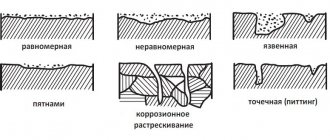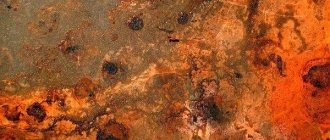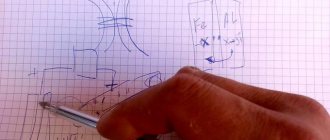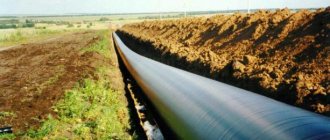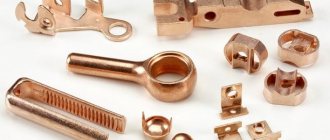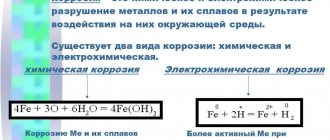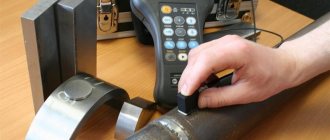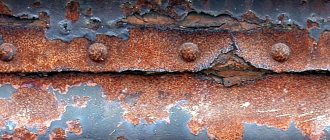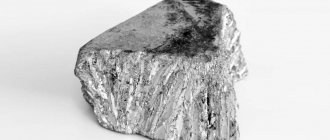The protection of metal structures and parts is carried out in accordance with regulatory and technical acts, ensuring compliance with the requirements of the profile standard - hot-dip galvanizing in accordance with GOST 9.307 89. This standard regulates the general standards regarding the quality of protective coatings that are applied to structural steel and high-strength steel by hot-dip galvanizing.
This technique can be used for processing shaped and rolled pipes, sheet steel, as well as products made of cast iron. This standard does not apply to coatings that are applied continuously.
Base metal requirements
Requirements for the design features of rolled products to be galvanized:
- The presence of air spaces and closed cavities in structures is not permitted. To apply the coating as efficiently as possible, the smallest cavities in the part must be accessible for the penetration and exit of molten zinc, liquids and gases.
- It is prohibited to apply a layer of zinc to products with areas in which there are closed spaces. This eliminates the possibility of an explosion. Parts with complex configurations and cavities are first subjected to trial processing.
- Welding of any elements of metal structures must be carried out end-to-end, with a one-sided seam with an underweld or with a double-sided seam. According to GOST requirements, hot-dip galvanizing of metal structures, the elements of which are welded overlapping, is not allowed.
Features of hot galvanizing
Hot-dip galvanizing is one of the few methods suitable for surface treatment of pipes of large length and diameter. Due to the relative simplicity of the technological process and the high quality of the resulting coating, hot-dip galvanizing is successfully used for processing pipes up to 12 m long and up to 350 mm in diameter.
Since when removing products from a zinc bath, influxes of frozen metal are possible, special attention during processing is paid to the overall dimensions of the products, the angle of removal of parts, and drainage holes for draining zinc on internal elements and in the cavities of metal structures.
Base metal surface requirements
Only rolled metal can be processed with zinc, on the surface of which there are no welding slags, burrs, pores, scale, or other inclusions.
If cast products and structures are subjected to processing, there should be no shrinkage cavities or other depressions on their surface. The presence of edges and sharp corners (unless there is a technical justification) is not allowed. Such parts must have roundings with a radius of at least 0.3 mm.
The structure of the welds must be dense and continuous along the entire length of the rolled product, on the surface of the welded joints the presence of slag inclusions, fistulas, welded joints, cracks and pores is not allowed.
According to the standards of the current GOST, hot-dip galvanizing is allowed provided that the surface of the rolled product is cleaned by degreasing, and also pickled or subjected to abrasive treatment, and subsequently fluxed. The coefficient of cleaning the surface of rolled metal from corrosion and scale should be 1. This is due to the requirements established by GOST 9.402.
Coverage Requirements
Appearance
After application, the zinc coating must have a continuous structure and be uniform, excluding the presence of nicks, cracks and blisters. It is accepted that minor roughness may be present on the surface itself. It is also possible that the coating can have different shades: from shiny silver to matte dark gray.
If there are ripples on the metal structure, scratches or marks left due to the capture of the part by lifting devices without destroying the integrity of the coating to the base metal, as well as grains of hartzinc, the diameter of which does not exceed 2 mm, this is not considered a defect. However, zinc leaks are not considered defective if they do not interfere with assembly.
It is allowed to restore uncovered areas, provided that their width is no more than 2 cm, and their total volume does not exceed 2% of the total area of the structure. Protection of uncoated areas is carried out using thermal spraying of zinc (the permissible minimum thickness is 120 microns) or by applying a zinc-containing paint layer to their surface (the amount of zinc in the mass of the dry film is 80 - 85%, the permissible minimum thickness is 90 microns).
Zinc coating thickness
The thickness of the protective layer should not be less than 40 microns, the maximum - no more than 200 microns. The choice of a specific thickness is determined based on the expected operating conditions of the treated structures, as well as the requirements specified in the regulatory and technical acts for a specific rolled product.
Adhesion strength
The coating has a sufficient level of adhesion, provided that it is able to withstand testing using any of the methods used (scratching, brushing, heating, blows with a rotary hammer).
Advantages of the method
Hot galvanizing of metal structures, when compared with other technologies, has a number of significant advantages.
- Even parts with highly complex geometric shapes can be processed using this technology. In particular, this technology is actively used for pipe processing.
- Areas of zinc coating damaged as a result of mechanical impact can self-heal, and this can happen without outside intervention.
- Compared to other galvanizing methods, the hot-dip galvanizing method allows you to form a coating whose resistance when interacting with liquid media is 6 times higher. It is for this reason that this technology is used for processing pipes and various containers.
- Hot-dip galvanizing allows you to effectively eliminate many defects of the surface being treated, such as holes, pores, etc.
- The operation of pipes and other hardware that are coated with zinc using this technology requires minimal financial costs. Their surfaces, in particular, do not require regular painting, since they are already reliably protected from the effects of negative environmental factors. This is very important for pipes that are used in hard-to-reach places (in walls, underground, etc.).
Comparison of cost and performance of hot-dip galvanized steel with other protection methods
Requirements for coating reliability and control of base metal
2–5% of products from a batch are subject to inspection, but not less than 3 units. All products of a single production are subject to control. Before applying a protective coating, these products are tested to ensure compliance with the standards that apply to the design and surface quality of the base metal.
Semi-finished products (rolled pipes, wire, etc.) are subject to incoming inspection, which involves checking parts for compliance with the standards that apply to the design and surface quality of the base metal, as well as the requirements that regulate regulatory and technical documents for delivery.
After application, the zinc coating is checked for several parameters such as thickness, appearance and adhesion strength. All consignments of goods are subject to inspection (a consignment is understood as a unit of cargo that includes one or more units with identical parameters that relate to one order). In this case, products on which a layer of zinc was applied during one work shift with immersion in the same bath are subject to control.
Control of adhesion strength and coating thickness is carried out in relation to the following metal products:
- Welded mechanisms in the amount of up to 5% of the batch, but not less than 1 unit;
- Parts of steel parts in the amount of up to 1% of the lot, but not less than 2 units;
- Threaded fasteners in a volume of up to 0.5% of the lot, but not less than 3 units.
To carry out inspections, methods of statistical control of hot-dip galvanizing are used in accordance with GOST 18242. The following standards are in force in Russia: GOST R 50779.71-99 and GOST R ISO 2859-1-2007.
Checking the thickness of galvanized coating using the metallographic control method is allowed to be performed only on one product from a batch.
Structures that have been tested using destructive methods may be submitted for acceptance upon completion of the coating restoration work.
All 100% of products are subject to inspection of the appearance of galvanized coating.
Coating thickness control
This parameter is checked before additional coating treatment (use of preservative lubricants, chromate plating, etc.). To carry out non-destructive testing, special measuring instruments are used, in which the permissible error does not exceed ±10%.
Control of layer thickness is carried out only on surfaces without threads and knurling at a distance of at least 5 mm from corners, edges, connecting areas and holes. Checking the thickness of the coating on elements and assemblies with threaded connections for fastening is carried out at the ends of the nuts and bolt heads.
If the test results were unsatisfactory, in accordance with GOST requirements, the specified parameters are re-monitored. In this case, double the number of products is subject to testing. If the repeated inspection also gives negative results, the entire batch of parts is considered defective.
Checking the contents of the bath during hot-dip galvanizing is carried out at the request of the client. The procedure is carried out before removing the parts from the bath.
GOST 9.307-89
This standard establishes general requirements for protective coatings applied by hot-dip galvanizing.
GOST 9.307-89 (ISO 1461-89) Unified system of protection against corrosion and aging (USZKS). Hot zinc coatings. General requirements and control methods
GOST 9.307-89 (ISO 1461-89)
Group T94
INTERSTATE STANDARD
Unified system of protection against corrosion and aging
HOT ZINC COATINGS
General requirements and control methods
Unified system of corrosion and aging protection. Hot-dip zinc coatings. General requirements and methods of control
MKS 25.220.40 OKSTU 0009
Date of introduction 1990-07-01
INFORMATION DATA
1. DEVELOPED AND INTRODUCED BY THE USSR State Construction Committee DEVELOPERS
S.V.Marutyan, Ph.D. tech. Sciences (topic leader), S.A. Klochko, L.N. Pavlova, S.G. Gutnik, L.M. Belousova
2. APPROVED AND ENTERED INTO EFFECT by Resolution of the USSR State Committee on Standards dated May 30, 1989 N 1379
3. The standard fully complies with international standards ISO 1461-89, ST SEV 4663-84
4. INSTEAD GOST 9.307-85
5. REFERENCE REGULATIVE AND TECHNICAL DOCUMENTS
| Designation of the referenced technical document | Item number |
| GOST 9.302-88 | 4.2.3 |
| GOST 9.402-80 | 1.2.5 |
| GOST 3118-77 | 4.2.3 |
| GOST 6709-72 | 4.2.3 |
| GOST 19251.1-79 — GOST 19251.3-79 | 4.3 |
| GOST 19251.5-79 | 4.3 |
6. REPUBLICATION This standard establishes general requirements (hereinafter referred to as the requirements) for protective coatings applied by hot-dip galvanizing (hereinafter referred to as coatings) on structural steel, including high-strength steel structures, shaped steel products and sheet steel, pipe sets, large diameter pipes, bent or welded prior to coating, containers, steel wire products, bulk processed fasteners, steel and iron castings, forgings, stamped steel products, and to base metal and coating quality control methods. This standard does not apply to coatings applied in a continuous manner.
1. REQUIREMENTS FOR THE BASE METAL
1.1. Requirements for the design of products to be galvanized
1.1.1. The structures should not contain pockets, closed cavities or air pockets; all cavities must be accessible for the unhindered entry and exit of liquids, molten zinc and gases. Hollow products and products of complex shape are subjected to trial galvanizing. To avoid explosion, it is not allowed to apply coatings to products that have closed cavities.
1.1.2. Welding of structural elements should be done end-to-end either with double-sided seams or with a one-sided seam with an underweld. It is not allowed to galvanize products with overlap welded joints.
1.2. Base metal surface requirements
1.2.1. Rolled scale, burrs, pores, inclusions, welding slag, residues of molding mass, graphite, lubricant, metal shavings, and marking paint are not allowed on the surface of the base metal.
1.2.2. There should be no pores or shrinkage cavities on the surface of cast products.
1.2.3. Welds must be uniform, tight and continuous along their entire length. Pores, fistulas, cracks, slag inclusions, and weld joints are not allowed.
1.2.4. Sharp corners and edges of products, except in technically justified cases, must be rounded with a radius of at least 0.3 mm.
1.2.5. The surface of products to be hot-dip galvanized must be cleaned by degreasing, subsequent pickling or abrasive treatment, and then fluxed. The degree of surface cleaning from scale and corrosion products is 1 according to GOST 9.402.
2. COATING REQUIREMENTS
2.1. Appearance of the coating
2.1.1. Upon external inspection, the surface of the zinc coating should be smooth or rough, the coating should be continuous. The color of the coating ranges from shiny silver to matte dark gray.
2.1.2. There should be no cracks, nicks, or swelling on the surface of the products.
2.1.3. The presence of zinc deposits is unacceptable if they interfere with assembly. Grains of hartzink with a diameter of no more than 2 mm, rippling of the surface, light gray spots and tarnished colors, scratches, scratches, traces of being caught by lifting devices without destruction of the coating to the base metal are not defects. It is permissible to restore uncovered areas if they are no wider than 2 cm and make up no more than 2% of the total surface area. Uncoated areas are protected with a layer of zinc-containing paint coating (minimum thickness 90 microns, mass fraction of zinc in the dry film 80%-85%) or thermal spraying of zinc (minimum thickness 120 microns).
2.2. Coating thickness The coating thickness must be no less than 40 microns and no more than 200 microns and is determined by the operating conditions of galvanized products and the regulatory and technical documentation for a specific product.
2.3. Adhesion strength The coating has satisfactory adhesion if it passes the tests according to the methods given in clause 4.4.
3. REQUIREMENTS FOR CONTROL OF BASE METAL AND COATING QUALITY
3.1. Before coating, 2%-5% of products from a batch, but not less than three, and for single-production products, each product is controlled for compliance with clauses 1.1, 1.2.
3.2. Semi-finished products (wire, pipes, etc.) are subjected to incoming inspection for compliance with the requirements of regulatory and technical documentation for delivery and the requirements of clauses 1.1, 1.2.
3.3. The applied zinc coating is subjected to control for appearance, thickness and adhesion strength. Each batch of galvanized products is submitted for inspection. A batch is defined as a unit of product or load consisting of one or more products of the same type and size belonging to the same order, if they are coated in the same shift and in the same bath.
3.4. Control of the appearance of coatings is carried out on 100% of products.
3.5. The thickness and adhesion strength are controlled by:
1) elements of steel structures in an amount of up to 1%, but not less than 2 pieces. from the party;
2) welded assemblies in an amount of up to 5%, but not less than 1 piece from the batch;
3) threaded fasteners in quantities up to 0.5%, but not less than 3 pieces per batch. It is allowed to use statistical control methods in accordance with GOST 18242*. ________________ * GOST R 50779.71-99** is in force on the territory of the Russian Federation. ** GOST R ISO 2859-1-2007 is in force on the territory of the Russian Federation. — Note from the database manufacturer.
Control of coating thickness by metallographic method can be carried out on one part from a batch.
3.6. Products on which quality control was carried out by destructive methods are allowed to be presented for acceptance after restoration of the coating.
3.7. Coating thickness control
3.7.1. Control of the coating thickness is carried out before its additional processing (chromate plating, application of preservative lubricants, etc.).
3.7.2. The thickness of the coating is controlled on a surface that does not have knurling or threads at a distance of at least 5 mm from the ribs, corners, holes and points of contact with the device. The thickness of the coating on threaded fasteners is controlled at the heads of the bolts and at the ends of the nuts.
3.7.3. The measuring instrument for non-destructive testing of coating thickness must have a measurement error of no more than ±10%.
3.8. If unsatisfactory results of monitoring thickness and adhesion strength are obtained, repeat testing is carried out on a double number of parts.
If unsatisfactory results of re-inspection are obtained, the entire batch of galvanized products is rejected.
3.9. At the customer’s request, the composition of the hot-dip galvanizing bath is monitored before removing products from the bath.
4. CONTROL METHODS
4.1. Control of appearance The appearance of coatings is controlled by visual inspection with the naked eye at illumination of at least 300 lux at a distance of 25 cm from the controlled surface.
4.2. Coating thickness control
4.2.1. Magnetic method The method is based on recording changes in magnetic resistance depending on the thickness of the coating. Magnetic thickness gauges are used as measuring instruments. The arithmetic mean of at least five measurements at the edges and in the middle of the controlled surface of one product is taken as the result of measuring the coating thickness. The relative error of the method is ±10%.
4.2.2. Metallographic method (arbitration) The method is based on measuring the thickness of the coating on a transverse section using metallographic microscopes of various types. The sample for making a thin section is cut out of a galvanized product. The thickness of the zinc coating is measured on a thin section at three or more points, evenly distributed over a linear section about 1 cm long. The arithmetic mean of the results of all measurements is taken as the result. The relative error of the method is ±10%.
4.2.3. The average thickness of the coating () in micrometers is determined by non-destructive methods or the gravimetric method by the difference in the mass of the sample before and after receiving or before and after removing the coating according to GOST 9.302. To remove the coating, use a solution: 3.2 g of antimony chloride or 2 g of antimony trioxide are dissolved in 500 cm of hydrochloric acid, density 1.19 g/cm, analytical grade, according to GOST 3118 in a 1 dm3 volumetric flask and adjusted to the mark with distilled water according to GOST 6709. The relative error of the gravimetric method is ±10%.
4.3. Control of the chemical composition of zinc melt - according to GOST 19251.1, GOST 19251.2, GOST 19251.3, GOST 19251.5. The mass fraction of zinc in the working volume of the bath must be at least 98%.
4.4. Monitoring the adhesion strength of coatings
4.4.1. Method of applying a scratch grid (for coating thicknesses up to 50 microns)
On the cleaned surface of the controlled coating with a tool with a steel tip at an angle of 30° (the hardness of the metal tip should be higher than the hardness of the coating), four to six parallel lines are applied with a depth to the base metal at a distance of 2.0 to 3.0 mm from each other and perpendicularly to them. The lines are drawn in one direction. The adhesion strength is satisfactory if no peeling of the coating is observed on the tested surface.
4.4.2. Brushing method For the brushing method, steel and brass brushes are used with a wire diameter of 0.1-0.3 mm and a brush rotation speed of 1500-2800 min. The surface of the coating is brushed for at least 15 s. After brushing, no swelling or peeling of the coating should be observed on the controlled surface.
4.4.3. Heating method When using the heating method, coated parts or witness samples are heated to (190±10) °C, maintained at this temperature for 1 hour and cooled in air. No swelling or peeling of the coating is allowed on the controlled surface.
4.4.4. Impact method with a rotary hammer The flat surface of the product with a base metal thickness of at least 3 mm is cleaned of dust, mechanical impurities and degreased with organic solvents. A rotary hammer weighing 212.5 g is installed on the flat surface of the product so that the head of the hammer falls vertically onto the horizontal surface of the product. Make at least two blows with a hammer so that the distance between parallel prints is 6 mm, and the distance from the edge of the print to the edge of the product is at least 13 mm. A diagram of the rotating hammer is shown in the appendix.
APP (recommended). DIAGRAM OF A ROTARY HAMMER
APPENDIX Recommended
1 - hammer; 2 - pressure plate; 3—sample surface; - size determined experimentally depending on the metal from which the hammer head is made
The electronic text of the document was prepared by Kodeks JSC and verified against: official publication Metal coatings.
Corrosion protection: Sat. standards. — M.: IPK Publishing House of Standards, 2005 comments powered by HyperComments
Coating thickness control
Magnetic method
This technique is based on recording changes in the level of magnetic resistance, which is due to different thicknesses of the layer being tested. For this purpose, special measuring devices (magnetic thickness gauges) are used.
The inspection process involves taking a minimum of 5 measurements in the central part and at the edges of the inspected surface of one part. The arithmetic mean value is taken as the result, based on the measurements obtained.
The permissible error of the magnetic method is ±10%.
Metallographic (arbitration) method
The technique is based on measuring the thickness of galvanized coating using a transverse section using metallographic microscopes of various types. The sample for creating a thin section is cut directly from the galvanized part.
Measurements of the coating thickness are carried out on a thin section in three or more zones, which are evenly distributed on the surface of the product (the length of the section is about 1 cm). The arithmetic mean of the measurements taken is taken as the result.
The permissible error of the metallographic method is ±10%.
Gravimetric method
Determination of the average thickness of the coating is carried out using non-destructive methods or using the gravimetric method based on data on the weight of the sample before and after receipt or before and after removal of the coating. This is due to the requirements regulated by GOST 9.302.
To remove the coating, use a solution consisting of 2 g of antimony trioxide or 3.2 g of antimony chloride, which is dissolved in 500 cm of hydrochloric acid, the density of which, according to GOST 3118, should be 1.19 g/cm, analytical grade. To prepare the solution in the required proportion, use a 1 dm3 flask, in which the mixture is added to the mark with distilled water, according to GOST 6709 standards.
The permissible error is ±10%.
Control of the chemical composition for hot-dip galvanizing is regulated by the requirements of the following GOSTs: 19251.1, GOST 19251.2, GOST 19251.3, GOST 19251.5.
According to the requirements of these standards, the mass volume of zinc in the working mass of the bath must be at least 98%.
INFORMATION DATA
1. DEVELOPED AND INTRODUCED by the State Construction Committee of the USSR
DEVELOPERS
S.V.Marutyan, Ph.D. tech. Sciences (topic leader), S.A. Klochko, L.N. Pavlova, S.G. Gutnik, L.M. Belousova
2. APPROVED AND ENTERED INTO EFFECT by Resolution of the USSR State Committee on Standards dated May 30, 1989 N 1379
3. The standard fully complies with international standards ISO 1461-89*, ST SEV 4663-84
________________
* Access to international and foreign documents mentioned in the text can be obtained by contacting the User Support Service. — Note from the database manufacturer.
4. INSTEAD GOST 9.307-85
5. REFERENCE REGULATIVE AND TECHNICAL DOCUMENTS
| Designation of the referenced technical document | Item number |
| GOST 9.302-88 | 4.2.3 |
| GOST 9.402-80 | 1.2.5 |
| GOST 3118-77 | 4.2.3 |
| GOST 6709-72 | 4.2.3 |
| GOST 19251.1-79 — GOST 19251.3-79 | 4.3 |
| GOST 19251.5-79 | 4.3 |
6. REISSUE
This standard establishes general requirements (hereinafter referred to as requirements) for protective coatings applied by hot-dip galvanizing (hereinafter referred to as coatings) on structural steel, including high-strength steel structures, shaped steel products and sheet steel, pipe sets, large-diameter pipes , bent or welded before coating, containers, steel wire products, bulk processed fasteners, steel and iron castings, forgings, stamped steel products, and to base metal and coating quality control methods.
This standard does not apply to coatings applied in a continuous manner.
Monitoring the level of adhesion strength of coatings
Heating method
The method involves heating witness samples or parts to a temperature of 190 ± 10 ℃. The parts are kept at this temperature for an hour and then cooled naturally (in air). The treated surface should have a uniform coating, excluding peeling and swelling.
Brushing method
The method involves the use of brass and steel brushes equipped with wire with a diameter of 0.1 to 0.3 mm. During surface treatment, the brushes rotate at a speed of 1500 – 2800 rpm.
The surface is brushed for 15 seconds. The treated surface should have a uniform coating, excluding the presence of swelling and peeling.
Scratch grid method
This method is used for coatings up to 50 microns thick. On the prepared surface, which has been previously cleaned, using a device equipped with a steel tip, apply 4 to 6 parallel and perpendicular lines. The notches are applied at an angle of 30° to a depth of the base metal at a distance of 2.0 - 3.0 mm from each other.
It must be taken into account that the hardness of the steel tip must be greater than the hardness of the coating. Lines are drawn in one direction. If there is no peeling of the coating on the treated surface, then the level of adhesion strength is considered sufficient.
Rotary Hammer Impact Method
Before checking, the surface of a part with a base metal thickness of 3 mm or more must be cleaned of dust and other contaminants, and then degreased using organic-based solvents.
A rotating hammer, whose mass is 212.5 g, is installed on the flat surface of the part so that its head falls strictly vertically on the part. Perform at least two blows with a hammer, maintaining a distance between prints of 6 mm. In this case, the distance from the edge of the print to the edge of the part must be at least 13 mm.

